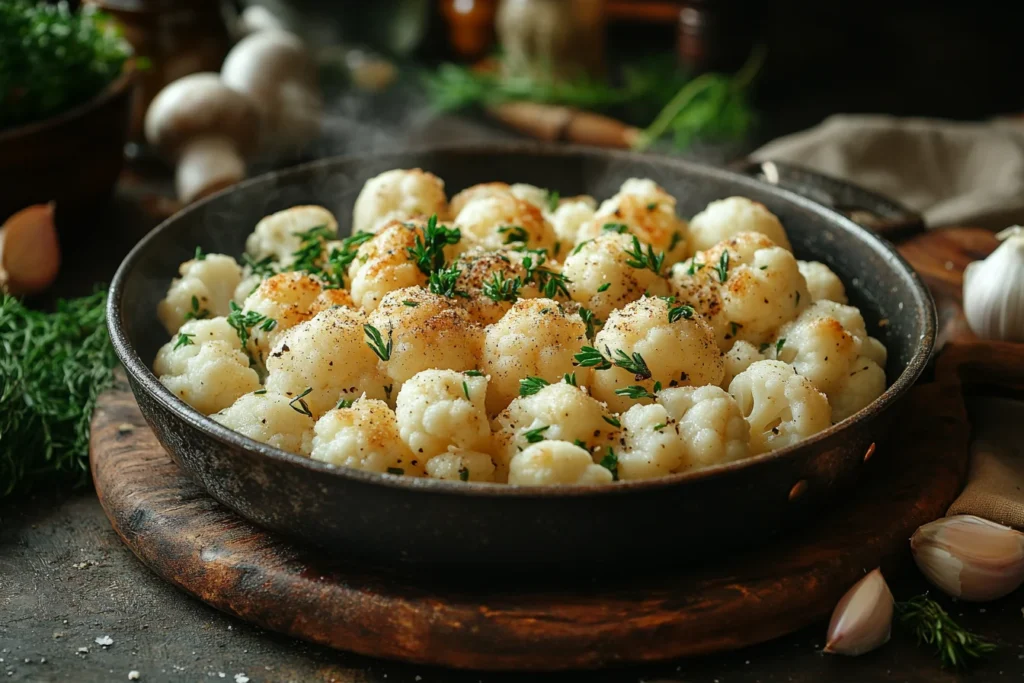Introduction
Cauliflower mushrooms are a rare culinary gem, loved for his or her difficult texture and earthy taste. Whether you’re foraging within the woods or choosing them up at a neighborhood marketplace, cleansing them can sense a chunk intimidating because of their unique structure. If you’ve ever wondered, “How do you clean a cauliflower mushroom?” this manual will walk you via the process little by little. Once cleaned, these mushrooms are ideal for creating scrumptious dishes like this cauliflower mushroom recipe or pairing with creamy flavors like on this hazelnut creamer recipe sweetened with condensed milk. With the proper strategies and equipment, you’ll ensure your mushroom is spotless and prepared for cooking.
Let’s dive into the entirety you want to realize to deal with this delicacy with care.

Table of Contents
Understanding Cauliflower Mushrooms
Before you learn how to clean a cauliflower mushroom, it’s essential to understand its structure. These mushrooms, scientifically known as Sparassis, resemble a head of cauliflower with curly, frilly branches. Their intricate shape makes them excellent for soaking up flavors in recipes, but it also traps dirt, pine needles, and insects.
Flavor Profile: Cauliflower mushrooms have a nutty, woodsy taste that intensifies when cooked.
Texture: They are slightly firm, with a satisfying crunch when prepared correctly.
Growth Habitat: Often found near the base of conifer trees, they grow in damp, wooded areas, which explains why they often carry forest debris.
Knowing these details will help you appreciate the cleaning process while ensuring you don’t damage their delicate structure.
Tools and Materials Needed
When considering how to clean a cauliflower mushroom, gathering the right tools is crucial. These materials will make the task easier and prevent damage to the mushroom’s fragile structure. Here’s what you need:
A clean sink or large bowl for rinsing.
A soft brush like a pastry brush or toothbrush for delicate cleaning.
Paper towels or a clean dishcloth for drying.
A sharp paring knife to remove damaged sections.
Cold water or a gentle saltwater solution to loosen debris.
Why these tools matter: The mushroom’s curls and crevices can easily trap dirt and insects, so precision and gentleness are key.
Inspecting Your Mushroom
The first step in how to clean a cauliflower mushroom is inspecting it thoroughly. Before you begin washing, take a few moments to evaluate its condition.
Look for visible debris: Carefully check the crevices for twigs, dirt, and insects.
Assess for damage: Remove any soft, slimy, or discolored sections with a paring knife.
Check for freshness: A fresh cauliflower mushroom should feel firm and have a mild earthy smell. Avoid mushrooms with a strong, unpleasant odor.
Preparing the Mushroom for Cleaning
Before diving into the actual cleaning process, you’ll want to properly prepare your cauliflower mushroom. This preparation step is critical to making the cleaning easier and more effective. Start by examining your mushroom closely. Look for any obvious debris, such as dirt, pine needles, or small insects, especially in the mushroom’s tightly packed curls. If there are soft or discolored spots, trim those areas away with a sharp paring knife.
Next, give the mushroom a gentle shake or tap over your sink or a bowl to dislodge loose dirt. This helps reduce the amount of debris you’ll need to remove during the rinsing process. After shaking, use a soft-bristled brush, like a pastry brush, to sweep away as much surface dirt as possible. Brush gently, working around the intricate folds and edges of the mushroom.
Finally, trim the mushroom’s base. The bottom section, where the stem connects to the soil, often holds the most dirt. A quick trim will make cleaning the rest of the mushroom easier. By completing these steps first, you’ll minimize the time spent rinsing and scrubbing, ensuring the mushroom is handled delicately and stays intact.
Cleaning Techniques for Cauliflower Mushrooms
Cleaning a cauliflower mushroom requires a combination of precision and gentleness to hold its elaborate shape at the same time as making sure it’s free of particles. Follow those strategies to smooth your mushroom efficaciously:
Rinse in Cold Water
Fill a large bowl or your sink with bloodless water. Submerge the mushroom fully and gently swirl it round. This enables loosen dust and forest debris trapped in its folds. Avoid using heat water, as it may regulate the mushroom’s texture. Replace the water if it becomes dirty in the course of the manner.
Spot Cleaning with a Brush
Use a tender-bristled brush, along with a pastry brush or a toothbrush, to clean the tighter areas. Work methodically, brushing from the middle outwards to keep away from pushing dirt in addition into the crevices. For stubborn debris, bear in mind the usage of a toothpick for precision.
Remove Damaged Sections
Trim any soft or discolored areas with a paring knife. These parts can affect the flavor and freshness of the mushroom.
Quick Saltwater Soak (Optional)
For heavily soiled mushrooms, a short soak in a mild saltwater solution can help dislodge tiny insects. Rinse thoroughly afterward to remove any salt residue.
Advanced Cleaning Tips for Cauliflower Mushrooms
For those who want to ensure their cauliflower mushrooms are pristine, advanced cleaning techniques can make all the difference. These tips help tackle stubborn debris while maintaining the mushroom’s delicate structure.
Use a Gentle Spray
If simple rinsing isn’t enough, try using a spray bottle filled with cold water. Gently spritz the mushroom, focusing on hard-to-reach areas. This method avoids over-soaking while targeting trapped dirt and insects.
Work in Sections
Break large cauliflower mushrooms into smaller, manageable pieces. Cleaning smaller sections allows better access to the intricate folds without the risk of missing hidden debris. Remember to reassemble them if presentation matters in your recipe.
Vinegar Rinse for Stubborn Dirt
Add a tablespoon of white vinegar to a bowl of cold water for an extra cleaning boost. Vinegar helps loosen dirt and acts as a mild disinfectant. Rinse thoroughly afterward to remove any residual taste.
Use a Soft Air Compressor
For the adventurous, a handheld air compressor (commonly used for electronics) can blow dirt out of the mushroom’s crevices without soaking it. This technique is especially helpful for foraged mushrooms.
Maintaining the Mushroom’s Texture
Cauliflower mushrooms have a delicate, curly structure that can easily lose its texture if mishandled. To keep them firm and flavorful, follow these key tips during and after cleaning.
Avoid Over-Soaking
Submerging the mushroom for too long can cause it to absorb water, leading to a soggy texture when cooked. Limit rinsing time to a few minutes, and always work in fresh, cold water.
Handle with Care
Be gentle when brushing or rinsing to prevent breaking the fragile curls. Use a soft touch while cleaning, and avoid pressing or squeezing the mushroom, as this can damage its natural shape.
Pat Dry Thoroughly
After cleaning, immediately pat the mushroom dry using paper towels or a clean kitchen cloth. Excess water can make the mushroom rubbery or dilute its flavor during cooking. Let it air dry on a towel for 20–30 minutes to ensure all moisture evaporates.
Cook Quickly
Once cleaned, store the mushroom properly and use it within three days. Fresh mushrooms retain their firm texture better and cook to a satisfying crunch, which is one of their best qualities.
Storage After Cleaning
Proper storage of your cleaned cauliflower mushroom is crucial to keep it fresh and flavorful. Since mushrooms can spoil quickly once washed, it’s important to follow these steps:
Dry Thoroughly Before Storing
After cleaning, pat the mushroom dry with paper towels or a clean kitchen cloth. Excess moisture encourages spoilage, so ensure it’s as dry as possible before storage. Let it air dry for 20–30 minutes if needed.
Use a Breathable Container
Store the mushroom in a paper bag or wrap it loosely in a kitchen towel. These materials allow airflow, which helps prevent condensation and keeps the mushroom from becoming slimy. Avoid airtight containers, as they trap moisture and accelerate spoilage.
Refrigerate Promptly
Place the wrapped mushroom in the refrigerator’s crisper drawer. This area maintains a steady, cool environment that’s ideal for fresh produce. Keep it separate from highly fragrant items like onions or garlic to avoid odor transfer.
Use Within Three Days
Cleaned mushrooms are at their best within 2–3 days. For longer storage, consider freezing the mushroom after blanching it briefly in boiling water, which helps preserve its texture and flavor.

Cooking with Cleaned Cauliflower Mushrooms
Once your cauliflower mushroom is cleaned and ready to go, the next step is transforming it into a delicious dish. With its nutty, earthy flavor and slightly crunchy texture, this mushroom works well in a variety of recipes. Here’s how to get the most out of it in the kitchen.
Sauté for Simplicity
Heat some olive oil or butter in a pan, add minced garlic, and toss in the mushroom pieces. Sauté over medium heat for 8–10 minutes until golden and tender. Sprinkle with salt, pepper, and fresh herbs for a quick side dish that lets the mushroom’s flavor shine.
Incorporate into Soups and Stews
The texture holds up beautifully in brothy dishes. Add the mushroom during the last 10–15 minutes of cooking to preserve its structure while absorbing the flavors of the broth or sauce.
Crispy Fried Treats
Coat small pieces in a light batter or seasoned flour and fry them until golden brown. These crispy bites make an irresistible appetizer or snack.
Pair with Pasta or Rice
Toss sautéed cauliflower mushroom with pasta, a drizzle of olive oil, and Parmesan cheese. Alternatively, mix it into a creamy risotto for a rich, satisfying meal.
Common Mistakes to Avoid When Cleaning Cauliflower Mushrooms
Cleaning cauliflower mushrooms requires patience and care. Rushing or skipping steps can lead to a disappointing result. Here are the most common mistakes and how to avoid them.
Skipping a Proper Inspection
Failing to thoroughly inspect the mushroom before cleaning is a common misstep. Dirt, pine needles, and insects can hide deep in its curls. Always check each section carefully and trim away any damaged or discolored areas before washing.
Over-Soaking the Mushroom
Leaving the mushroom submerged in water for too long can make it soggy and dilute its flavor. To avoid this, rinse quickly and change the water as needed. Keep soaking time to just a few minutes to preserve its firm texture.
Using Harsh Cleaning Tools
Abrasive brushes or scouring pads can damage the mushroom’s delicate structure. Always opt for soft-bristled brushes or toothbrushes to gently remove dirt without tearing the curls.
Not Drying Properly
Storing a wet mushroom leads to slimy, spoiled sections. After cleaning, pat the mushroom dry thoroughly with paper towels and allow it to air dry before refrigerating.
Improper Storage
Storing cleaned mushrooms in airtight containers or plastic bags traps moisture and accelerates spoilage. Instead, use a breathable paper bag or wrap the mushroom loosely in a kitchen towel for proper airflow.
Cleaning Too Late
Waiting to clean until just before cooking can mean rushing through the process. Clean the mushroom as soon as possible after harvesting or purchasing to give yourself time to handle it carefully.
By avoiding these common mistakes, you’ll keep your cauliflower mushroom fresh, flavorful, and ready for your next recipe.
Health and Safety Tips for Cleaning and Preparing Cauliflower Mushrooms
Cleaning and preparing cauliflower mushrooms isn’t just about making them look good it’s also important to handle them safely to protect your health. Follow these essential tips to ensure your mushrooms are safe to eat and retain their unique flavor.
Choose Fresh Mushrooms
Always start with fresh, firm cauliflower mushrooms. Avoid mushrooms that feel slimy, have a strong odor, or show significant discoloration, as these may indicate spoilage. If you’re foraging, be certain of the mushroom’s identity. Mistaking a cauliflower mushroom for a toxic lookalike can have serious health consequences.
Wash Hands and Tools
Before handling mushrooms, wash your hands thoroughly to prevent transferring bacteria or dirt. Use clean knives, brushes, and towels for trimming and cleaning. Avoid cross-contamination by keeping raw meats and other uncooked foods separate from the mushrooms during preparation.
Rinse, Don’t Soak (When Possible)
Although a quick soak can help dislodge dirt, mushrooms absorb water easily. Too much water not only impacts their texture but may also harbor bacteria if not dried properly. Work swiftly when submerging them and ensure they are dried thoroughly.
Inspect for Hidden Debris
Cauliflower mushrooms’ curly structure can trap tiny insects and forest debris. Be meticulous when inspecting and cleaning every crevice. Eating improperly cleaned mushrooms can lead to unpleasant surprises or digestive discomfort.
Cook Thoroughly
Mushrooms should always be cooked before eating. Cooking not only enhances their flavor but also destroys any bacteria or pathogens present on the surface. Sautéing, frying, or boiling ensures the mushrooms are safe to consume.
Store Safely
After cleaning, store mushrooms in a paper bag or towel-lined container in the refrigerator. Avoid airtight plastic bags, as they can trap moisture and encourage mold growth. Consume cleaned mushrooms within 2–3 days for the best taste and safety.
FAQs About Cleaning Cauliflower Mushrooms
How do you clean a cauliflower mushroom without damaging it?
Gently rinse it in cold water, use a soft brush for tight spots, and avoid over-soaking. Handle it carefully to preserve its delicate curls.
Can I eat a cauliflower mushroom raw?
No, it’s best to cook cauliflower mushrooms. Cooking enhances their flavor and ensures they’re free of harmful bacteria or debris.
How should I store cleaned cauliflower mushrooms?
Store them in a paper bag or wrap them in a towel in the fridge. Use them within 2–3 days to maintain freshness.
What if my cauliflower mushroom has bugs or dirt stuck in it?
A quick saltwater soak can help loosen dirt and insects. Rinse thoroughly afterward to remove any residue.
Can I clean cauliflower mushrooms ahead of time?
Yes, you can clean them a day or two in advance. Store them in the refrigerator in a paper bag or wrapped in a towel to keep them fresh.
Do I need special tools to clean cauliflower mushrooms?
Not necessarily. A soft brush, a bowl of cold water, and a small knife are enough to remove dirt and debris effectively.

Conclusion
Cauliflower mushrooms are a completely unique issue that deliver texture and flavor to pretty a few dishes, but their tricky shape calls for careful cleansing to prepare them properly and correctly. While their curls and crevices might also seem daunting at the start, following a step-with the aid of-step cleaning manner ensures that your mushroom is free from dirt, bugs, and particles at the same time as retaining its touchy shape.
By beginning with an inspection, gently rinsing and brushing, and drying very well, you can hold the mushroom’s nutty flavor and corporation texture. Skipping any of those steps, which include over-soaking or wrong drying, can compromise each the extraordinary and safety of the mushroom. Proper dealing with doesn’t prevent at cleansing—storing the mushroom in a breathable subject and using it interior a few days guarantees it remains glowing and ready to apply.
Cooking with a clean cauliflower mushroom is a worthwhile experience. Whether you’re sautéing it with butter and garlic, adding it to a comforting soup, or frying it into crispy bites, the effort you placed into cleaning may be pondered inside the dish’s taste and presentation. With a bit persistence and the right strategies, you can with a bit of luck experience this wild culinary gem, information it’s been prepared with care.

